Here’s a question for you: Did today seem like it was going to be a really good day?
Did the stars align, did the birds sing, did you high-five yourself after jogging three miles and only eating precisely 300 calories for breakfast, thanks to a McDonald’s sausage burrito?
Well, prepare to be slightly miffed, because it turns out that a lot of those labels? Yeah, those labels lie.
What? Calorie-count labels are inaccurate? What madness is this?
Well, here’s what’s up: essentially, about one in five of those calorie-count labels are inaccurate.
There’s usually a margin of inaccuracy around 100 calories, which may not sound like too much (spoonful of peanut butter) but this can add up over time (an entire jar of peanut butter).
For those of you who are obsessive about labels, well, the good news is some of the labels are accurate. But not all. It’s hard to tell.
Uncertainty and diet concerns aside, I’d like to address why this is even happening.
Well, for one thing, the Food and Drug Administration has been pushing a requirement that for restaurants with 20 or more locations offer similar fare under the same name (Applebee’s, Chili’s, etc.) to provide nutrition information to their customers, which explains why you see the terrifying calorie counts plastered next to food items at places like Subway or McDonald’s.
However, though health departments require the posting of this information, it is incredibly rare that one really actually goes and verifies these caloric labels are accurate.
“Hey” you say, “What’s the big deal with testing my triple-shot-soy-chocolate-pumpkin-blueberry-caramel Starbucks latte? Don’t they just measure it or something?”
Good one, naïve college freshman, with your ridiculous Starbucks order!
Of course they don’t test it because it turns out that measuring calories takes a lot of time out of your day.
Just a wee bit boring, then.
To test your food objects requires an awful lot of math, patience, time and sensitive equipment (such as a calorimeter. Ask for one for your next birthday).
In a video posted on popular website Laughing Squid, filmmaker Casey Neistat grabbed five typical food items and took them to an obesity center to be tested by food scientists using a calorimeter, and the entire process took them 10 hours.
Ten hours, people. That’s almost two episodes of “Downton Abbey.”
I’m just messing with you. It’s at least three episodes. So clearly, this is ridiculous.
America has enough problems on its hands without having inaccurate calorie labeling to contend with, too. Those people on diets are really frustrated because all that hard work can be sabotaged by a stray sandwich at Subway, or a misplaced meat patty at McDonald’s.
It’s time for accurate calorie counts, correct calorie labeling and regular calorie testing.




















































































